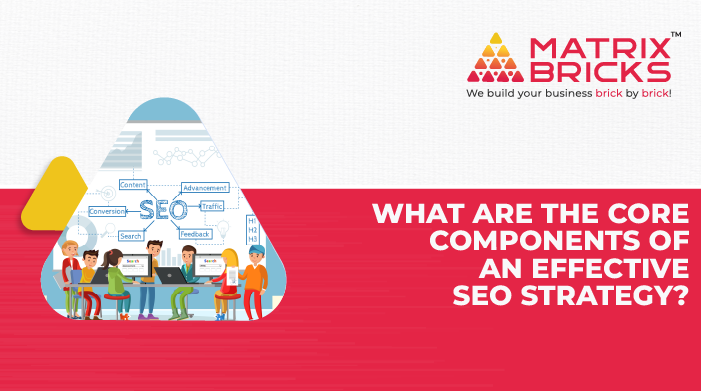
In today’s digital landscape, an effective SEO (Search Engine Optimization) strategy is crucial for any business looking to enhance its online presence, attract more visitors, and convert leads into customers. Understanding and implementing the core components of SEO can significantly improve your website’s visibility on search engines like Google, Bing, and Yahoo. This in-depth manual will explore the fundamental components of a successful SEO strategy and offer practical advice to help you thrive in the cutthroat realm of internet marketing.

Understanding SEO
Search engine optimisation, or SEO, is the act of making changes to your website so that it ranks higher in search engine results pages (SERPs). By employing various search engine optimization strategies, you can enhance your website’s visibility, attract more traffic, and achieve better conversion rates. SEO encompasses different tactics and techniques, broadly categorized into on-page SEO and off-page SEO. Let’s break down these core components to build a comprehensive SEO plan.
Core Components of an Effective SEO Strategy
1. Keyword Research and Optimization
Any effective SEO approach starts with keyword research. Identifying relevant keywords and phrases that your target audience is likely to use when searching for products or services is crucial. These keywords should be incorporated into your website’s content, meta tags, headers, and URLs. Utilizing effective search engine optimization techniques ensures that your content is aligned with what users are searching for.
Tips for Effective Keyword Research:
- Use Keyword Tools: Utilize tools like Google Keyword Planner, SEMrush, and Ahrefs to discover relevant keywords and assess their search volume, competition, and relevance.
- Analyze Competitors: Examine the keywords your competitors are ranking for to identify gaps and opportunities.
- Long-Tail Keywords: Pay attention to these more specialised terms that have a greater chance of conversion and less competition.
2. On-Page SEO
On-page SEO refers to the optimization of elements within your website that affect its search engine ranking. This includes:
- Title Tags and Meta Descriptions: Crafting compelling and relevant title tags and meta descriptions can improve click-through rates (CTR) from search results.
- Header Tags: Using header tags (H1, H2 and H3) to structure your content helps search engines understand the hierarchy and relevance of information on your page.
- URL Structure: Creating SEO-friendly URLs that include relevant keywords can enhance your site’s visibility and user experience.
- Content Optimization: Ensuring your content is well-written, informative, and includes relevant keywords is essential for both users and search engines.
- Image Optimization: Adding alt text to images helps search engines understand the content of your images and improves accessibility.
Implementing on-page SEO techniques ensures that each page of your website is optimized to meet search engine guidelines and user expectations.
3. Off-Page SEO
Off-page SEO refers to the optimization efforts that occur outside your website but still impact your search engine rankings. Key components of off-page SEO include:
- Backlink Building: Acquiring high-quality backlinks from authoritative websites signals to search engines that your content is valuable and trustworthy. Try to compile links from reputable and relevant sites.
- Social Media Engagement: Using social media to promote your content can boost traffic and brand awareness. Social signals could have an indirect effect on your search engine rankings.
- Local SEO: This includes optimizing your Google My Business listing, getting reviews, and ensuring your business information is consistent across online directories.
By employing effective off-page SEO strategies, you can build your website’s authority and credibility, which positively impacts your search engine rankings.
4. Technical SEO
Technical SEO involves optimizing your website’s technical aspects to improve its crawlability and indexability by search engines. Key elements include:
- Site Speed: A fast-loading website provides a better user experience and can positively affect your search rankings. Sources such as Google Page Speed Insights can be used to identify and resolve speed issues.
- Mobile-Friendliness: With the rise of mobile search, ensuring your website is mobile-friendly is crucial. To ensure a flawless experience across all devices, use responsive design.
- XML Sitemaps: Creating and submitting XML sitemaps helps search engines discover and index your pages more efficiently.
- Robots.txt: Using the robots.txt file to control which pages search engines can crawl helps prevent the indexing of duplicate or irrelevant content.
Technical SEO is a vital component of your overall SEO strategy, as it ensures that your website is accessible and performs well for both users and search engines.

5. Content Strategy
Developing a robust content strategy is essential for driving organic traffic and engaging your audience. This involves:
- Creating High-Quality Content: Focus on producing content that is informative, engaging, and valuable to your target audience. Content should address user intent and provide solutions to their queries.
- Content Calendar: Organising and scheduling your content guarantees that it is consistently published, fresh, and pertinent. It also helps to maintain consistency.
- Content Diversification: Incorporate various content types, such as blog posts, infographics, videos, and case studies, to appeal to different audience preferences and improve user engagement.
A well-defined content strategy enhances your website’s relevance and authority, contributing to improved search engine rankings.
6. Backlink Building
Inbound or backlinks are links originating from other websites that point to your own website. They play a crucial role in establishing your site’s authority and credibility.
Strategies for Building Quality Backlinks:
- Content Outreach: To market your content and obtain backlinks, get in touch with bloggers and industry influencers.
- Guest Posting: Write guest posts for reputable websites in your niche, including a link back to your site.
- Broken Link Building: Look for links that are broken on other websites and provide your material as a substitute.
7. Local SEO
Local SEO is essential for firms aiming to reach a local audience because it draws clients from particular regions.
Local SEO Techniques:
- Google My Business: Fill out your profile with correct details, such as your address, phone number, and business hours, and optimise it.
- Local Citations: Make sure your company has consistent NAP (Name, Address, Phone Number) information included in local directories and citation sources.
- Local Keywords: To draw clients from the area, use local keywords in your meta tags and content.
8. User Experience (UX)
User experience (UX) focuses on creating a positive and intuitive experience for visitors on your website. A good UX not only helps retain users but also signals to search engines that your site is valuable.
UX Best Practices:
- Navigation: Design a user-friendly navigation structure that makes it easy for visitors to find information.
- Design: Ensure your website has a clean and attractive design that aligns with your brand and engages users.
- Accessibility: Make your site accessible to all users, including those with disabilities, by following web accessibility guidelines.
9. Analytics and Monitoring
It’s essential to track and evaluate your SEO efforts in order to comprehend results and make informed judgements.
Monitoring and Analytics
Continuously monitoring and analyzing your SEO efforts is crucial for optimizing your strategy. Key metrics to track include:
- Organic Traffic: Count the amount of people who find you through search engines to gauge how well your SEO tactics are working.
- Keyword Rankings: Monitor your keyword placements to gauge the effectiveness of your optimisation efforts.
- Conversion Rates: Analyze how well your website converts visitors into customers or leads.
- Bounce Rates: Monitor bounce rates to understand if users are finding what they’re looking for on your site.
Using tools like Google Analytics and Google Search Console helps you gather insights and make data-driven decisions to refine your search engine optimization strategies.
10. Continuous Improvement
SEO is an ongoing process, and continuous improvement is key to staying ahead in search rankings. Regularly update and optimize your content, stay informed about industry trends, and adapt to changes in search engine algorithms.
Strategies for Continuous Improvement:
- Content Updates: Refresh old content to keep it relevant and up-to-date.
- Algorithm Changes: Stay informed about updates to search engine algorithms and adjust your strategy accordingly.
- Competitor Analysis: Regularly review your competitors’ strategies and identify opportunities for improvement.
Conclusion
A successful SEO plan consists of a few essential elements, each of which is essential to increasing the exposure of your website and drawing in relevant traffic. By focusing on keyword research, on-page and technical SEO, content quality, backlink building, local SEO, user experience, analytics, and continuous improvement, you can create a robust SEO strategy that drives long-term success. Remember, SEO is not a one-time effort but a continuous journey of optimization and adaptation. Implement these core components, stay committed, and watch your online presence thrive.
For more insights on enhancing your digital marketing efforts, follow our blog and stay updated with the latest SEO trends and best practices.





